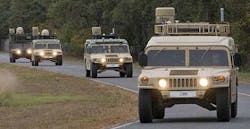Army eyes open-systems standard for SATCOM networking on the move for big combat vehicles
ABERDEEN PROVING GROUND, Md., 9 June 2013. U.S. Army researchers say they would like to develop an open-systems standard to enable the Army to develop or buy off the shelf distributed aperture satellite communications antennas for mounting on vehicles for on-the-move communications.
The Army Communications Electronics Research & Development Engineering Center (CERDEC) Space & Terrestrial Communications Directorate (S&TCD) at Aberdeen Proving Ground issued a request for information last week asking industry for suggestions on such an open-systems standard applicable to the Distributed and Embedded Standard SATCOM On-The-Move Terminal Architecture (DESSTA).
Researchers would like a future DESSTA standard to influence development of product line that will include the capability of full networking on-the-move. This effort is under direction of the Army's Program Manager Warfighter Information Network-Tactical (PM WIN-T).
One of the challenges Army researchers face is how to integrate a SATCOM-on-the-move onto ground vehicles such as the future heavy Ground Combat Systems (GCS) and Armored Brigade Combat Team (ABCT) vehicles.
To meet this challenge, researchers particularly are interested in distributed-aperture terminals. Heavy armored combat vehicles have turreted weapon systems, which limits space and power for a SATCOM terminal.
A distributed aperture terminal could be mounted on the sides of the turret or somewhere else on the outside of the vehicle, rather than on the top of the turret, where it can obstruct or pose a danger to the vehicle's crew.
Army researchers have learned about mounting distributed aperture SATCOM terminals on land vehicles from programs like the Small Aperture X-Band Antenna - Distributed Broadband (SAXBA BB), yet they still need to figure out the best distributed-aperture SATCOM terminal architecture to meet performance cost goals.
Researchers say they would like to develop an affordable networking-on-the-move SATCOM terminal that operates in X, Ku, Ka, and perhaps other frequency bands. The DESSTA program will answer this need in the near term, but for the future Army experts still want to develop a family of cost-effective terminals.
DESSTA will first develop a baseline open standard architecture for distributed aperture SATCOM-on-the-move terminals in X, Ku and Ka bands, and then develop a Ku band distributed aperture SATCOM-on-the-move terminal prototype to align with the needs of the WIN-T program.
The DESSTA open standard architecture development effort for X/Ku and Ka bands will run over the next three to four years, yet the Army will need a baseline standard architecture for Ku band by the end of fall 2013.
The objective of the open standard is to reduce the cost of the distributed aperture terminal with modular terminal designs. The standard will define the components of the distributed aperture SATCOM-on-the-move terminal, the functionalities of each component, and the common interfaces between each component. Within each component vendors will be able to implement their unique proprietary solutions, Army officials say.
The distributed SATCOM-on-the-move open-standard architecture will not tied to a specific vendor, and will be published and used without royalties or non-disclosure agreements.
Researchers also are trying to understand existing antennas designs, low-cost array manufacturing techniques, antenna tracking and control systems, and other technologies that could help them develop distributed SATCOM terminals.
Descriptions of the standard should include components of the distributed terminal; the functionality of each component; the need for additional components; what interfaces exist in distributed terminal architectures; the need for cabling; and design tradeoffs.
Companies interested should email their ideas no later than 8 July 2013 to the Army's Jeffrey Hoppe at [email protected] or Jim Gallagher at [email protected].
For questions or concerns contact Hoppe and Gallagher by e-mail or Hoppe by phone at 443-395-9643, or Gallagher at 443-395-9629.
More information is online at https://www.fbo.gov/notices/c154f3423f908cf8b13e62e7ed4f7e02.

